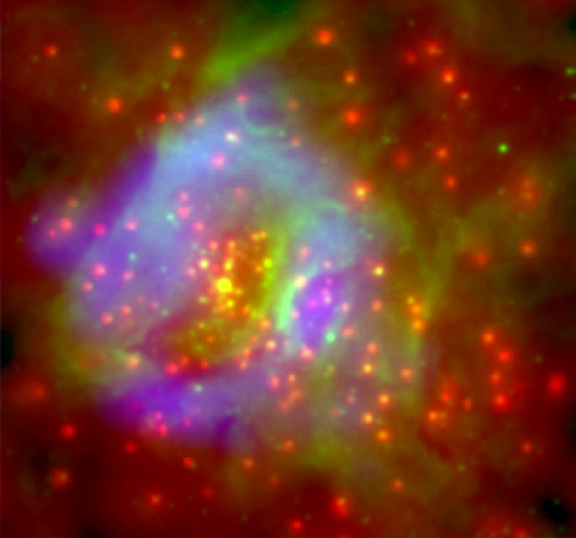
 Credit: X-ray: NASA/CXC/CfA/S.Wolk et al.; Infrared: ISAAC/VLT; Radio: ATCA
Credit: X-ray: NASA/CXC/CfA/S.Wolk et al.; Infrared: ISAAC/VLT; Radio: ATCA
Young Stars, Surprisingly Energetic
Comparative astronomy is important in order for astronomers to fully understand the rich interaction of physical mechanisms at play in the Universe. This is particularly true in regions where stars are forming, where phenomena run the gamut from very low energy to very high energy. A beautiful example of this is the star cluster RCW 38, a grouping of about 1000 stars which formed about 1 million years ago.
The image above is a composite of RCW 38 which shows Chandra X-ray data (0.5-8 keV) in red, IR data from the ISAAC infrared camera (at a wavelength of 2.2 micron) in green and Australian Telescope Compact Array radio data (at a frequency of 1660.0 MHz = wavelength of 18cm) in blue. The blue radio emission forms a ring which appears to confine a region of gas heated by the immense radiation from the massive, young stars; the IR observations reveal secrets of the cluster hidden behind a very thick molecular cloud. Perhaps most astonishing, diffuse X-ray emission apparently shows surprisingly high energy physical processes at work, perhaps produced by a strong magnetic field whose origin can currently only be guessed at.
Last Week *
HEA Dictionary * Archive
* Search HEAPOW
* Education
Each week the HEASARC
brings you new, exciting and beautiful images from X-ray and Gamma ray
astronomy. Check back each week and be sure to check out the HEAPOW archive!
Last modified December 23 2002


